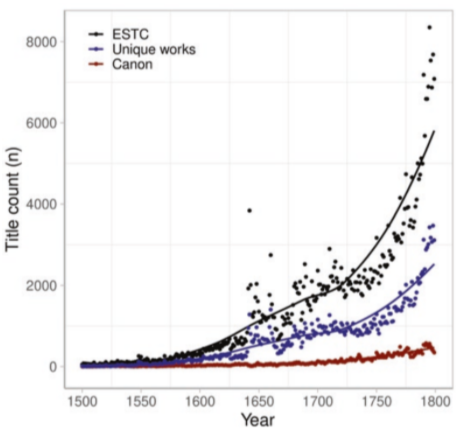The Queries Collection was one of several texts in the Lapidus Collection to address the question of Jews in England and the Naturalization Act of 1753 in particular. The texts in the collection are drawn disproportionately from the year 1753 and represent debate around the Naturalization Act.
To get a better sense of the historical context for these texts and the debate around the Naturalization Act, I conducted systematic searches of the English Short Title Catalogue to look at the history of political debate in England around Jews and Judaism in general. Specifically, the decade-by-decade number of results on a search of the terms () is represented on the timeline below.
The English Short Title Catalogue is a catalogue with entry listings for over 480,000 items published between 1473 and 1800, primarily written in English and published in the British Isles and North America1. The ESTC contains the holdings of 2,000 or so libraries and is comprehensive enough to be used as a quantitative measure of issue salience within popular culture2
Turning now to the prevalence of debate over Jews, we can see an initially low rate of publication about Jews in England which then spiked during the 1650’s before falling to a higher steady rate for the next century or so. The rate then spikes again during the 1750’s before falling back to the previous rate, with an additional spike in the 1790’s.
The first immediately obvious point about this timeline is its correspondence with the history of the status of Jews in England. Initially when Jews were not permitted in England, there was a very low rate of publications mentioning Jews. The rate was higher in the 1650’s and after, when Jews were allowed to live in England.
In addition, there were large spikes at the two times when Jewish status was in question — when Jews were permitted to return to England in the 1650’s and when the Jewish Naturalization Act was passed, then repealed in 1753-4.
In fact, the increase in publication rates at the time of the Jewish Naturalization Act was more dramatic than just the twofold increase that appears on the graph above. If we zoom in to look year by year at that time, we can see the difference between 1753 and surrounding years was in fact closer to a fivefold increase.
These particularly high rates of publication owe to widespread debates over toleration towards the Jews that occurred during each spike.
However, before we consider the implications of the observed timeline trends, we should notice that this interpretation of the timeline fails to take into account the base rate of publication as recorded in the ESTC, which shows increases throughout the time periods in question. This is important to consider because we can’t otherwise tell if these increases are because the Jews and Judaism are becoming more salient or just because there were more texts in general being written and/or archived.
Prior work has already charted the overall annual publication rate as captured by the ESTC (cite), and the figure reproduced below shows that publication increased steadily over the three centuries between 1500 and 1800, with a linear increase between 1600 and 1725 followed by spiking sharply in the later half of the 18th century.

In particular, the first observation of a higher rate from the 1650s and onwards is not as clear cut as it would initially appear. That being said, the trend does still hold, at least looking relatively soon after the 1650’s. The jump in Jewish-related publication rate from the 1630’s to 1660’s is about a tenfold increase, which is certainly higher than the jump in base publication rate that seems to be around a twofold or threefold increase. On the other hand, if we look after the Naturalization Act to the 1770’s or 1780’s, we see a tenfold increase in Jew-related publication rate from the 1630’s to 1660’s, which is similar to the increase in base publication rate over the same time period. Overall, we can now more accurately interpret the general trend in Jew-related publication rate as showing an sudden increase when Jews were permitted to return to England in the 1650’s, but also a decrease throughout the late 1600’s and 1700’s that eventually brings the rate down to pre-1650 levels in the late 18th century.
For the most part, the interpretation of the spikes in publication rate remain the same: the first two spikes correspond to the return of Jews to England and then the Jewish Naturalization Act. However, the 3rd spike that was previously unexplained can now be observed to result from the spike in base publication rates in the ESTC in the 1790’s. Overall, this is a worrying sign for the question of Jewish toleration, since the records imply that the debate is all but forgotten following the repeal of the Naturalization Act. Even more worryingly is that of those texts that are still being published relative to Jews and Judaism in England after 1754, a great many of them are antisemetic religious analyses rather than support for Jewish naturalization or actual debates over toleration towards Jews.
It is no surprise, then, that we don’t see any real improvements to the Jewish status in England until 1830, nearly a century later.
The text this site focuses on presents a case study of the debate around the Naturalization Act that occurred in England in 1753, where we will see arguments from both sides and how the distribution of anti-semitic arguments and misleading narratives set the scene for almost a century of stalled progress in the advancement of the status of Jews in England.
